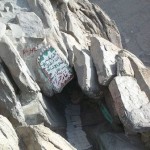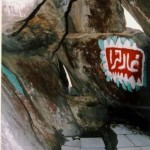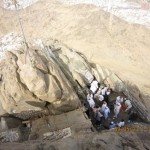Frequently, Muhammad had visitations and conversed with a spirit that identified himself as Gabriel. Contrary to biblical teaching, the scriptures verified opposing narratives, which states that once or twice in the lifetime of a saint that the angels contacted them in the Tanach and New Testament. To the contrary, in shamanism, the greater number of visitations by the spirits the more power one possessed. Muhammad followed the way of the shaman rather than the way of the biblical prophets and saints.
The Stone Cults and Shamanism
Muhammad was reared in one of the chief pagan centers of ancient Arabia. This pagan background inevitably made him susceptible to demonic influence. Muhammad’s father was named after the moon-god Allah. He continued to follow the god of his father as well as venerate the Black Stone. In Muhammad’s time, Arab custom incorporated the stone cult and involved rubbing sacred stones for divine assistance. This type of shamanic practice has been documented among many cultures throughout the world. For instance, an Ammasalik Eskimo initiate is told “to isolate himself in a lonely place . . . and there to rub two stones together while waiting for the significant event.”[14] Eliade continued the narrative:
“Then the bear of the lake or the inland glacier will come out, he will devour all your flesh and make you a skeleton, and you will die. But you will recover your flesh, you will awaken, and your clothes will come rushing to you.”[15]
It was common for the initiate to rub “stones all through the summer, and even through several consecutive summers, until the time comes when he obtains his helping spirits. . . .”[16] Quite likely, the young Muhammad practiced a similar feat to obtain his special guardian spirit. Throughout his life, he touched and venerated the Black Stone of the moon-god Allah. Once again, Muhammad pursued the lineage of the shamans by following their agenda.
The Demon Cave Spirit
Another technique in shamanism for obtaining a guardian spirit involves location. Harner expands upon this:
“The best way to acquire a guardian spirit is in a remote place or wilderness. The location may be a cave, the top of a mountain, or a tall waterfall or an isolated trail at night.”[17]
Repetitively, the cave had been used in the initiation of Australian medicine men, the Malekula shamans, the Smith Sound Eskimo, the Araucanian shamans of Chile, and North American Indians.[18] Around the world many other tribes utilized caves to summon up apparitions. Harner further states: “In North America, candidates withdraw to mountain caves or solitary places and seek, by intense concentration, to obtain the visions that can alone determine a shamanic career.”[19] On occasions, the biblical prophets withdrew to solitary places, but the cave occurrences persisted predominantly in shamanic initiation to entreat and converse with the spirit world.
Spending many days in caves, an attempt to contact his guardian spirit, Muhammad eventually achieved his first revelation. Muhammad’s young wife, Aisha, narrated, as recorded in the Hadith:
And then the want of seclusion became beloved to him. He used to seclude in the cave of Hira to worship for many days and nights before going to see his family; and take provision for that. Then he would come back to (his wife) Khadija to take his food like-wise again till suddenly the Truth descended upon him while he was in the cave of Hira.[20]
Aisha continued the famous account of Muhammad’s first revelation:
The angel came to him and asked him to read. The prophet added: I do not know how to read. The angel caught me (forcefully) and pressed me so hard that I could not bear it any more. He then released me and again asked me to read and I replied: I do not know how to read. Thereupon he caught me again and pressed me a second time till I could not bear it any more. He then released me and again asked me to read but again I replied: I do not know how to read (or what shall I read)? Then he caught me for the third time and pressed me, and then released me and said: Read in the name of your Lord, who has created man from a clot. Read! And your Lord is the Most Generous (96:1,2,3). Then Allah’s Apostle returned back with his heart trembling. He came to Khadija . . . and said: Cover me! Cover me! They covered him till his fear was over.[21]
Tabari, the Islamic historian, claims two different terminologies were used in Arabic for the angel pressing Muhammad. He exegetes “The word ghammahu (he afflicted or grieved him)” and “ghattani of the previous account (he pressed tightly until I was nearly stifled).”[22] In Tabari’s modern translation, the word translates into English, “Gabriel was violent towards him.”[23] The terror-stricken Muhammad immediately thought himself to be possessed by a Jinn or possibly “a poet or a madman.”[24] Muhammad was so distraught after such events that he often would attempt to commit suicide by jumping off a mountain or cliff. However, the spirit entity always intervened to stop him.
The violence that was inflicted upon the initiated occurs repeatedly in the shamanic experience. Among the South American shamans, “a spirit, Pasuka, appears to the candidate in the form of a warrior. The master (spirit being) immediately begins to strike the apprentice (shamanic candidate) until he falls to the ground unconscious. When he revives his body, it is completely sore. This proves that the spirit has taken possession of him.”[25] Ultimately, whether immediately or any subsequent time, the spirits of any occult art will eventually manifest or reveal themselves in a violent manner. Muhammad apparently experienced this indoctrination by his spirit guide.
Immediately after such shocking spirit encounters, Muhammad would seek solace and comfort from his wife Khadija. She was his elder cousin and had hired him as a traveling salesman and was impressed with his abilities in selling. Khadija was forty years old and Muhammad twenty-five when she proposed to him for marriage. When Muhammad returned from his frightening cave experience, she had to cover him with blankets, such as would be done for any patient with symptoms of shock. Looking at it from a biblical perspective, if the spirit in the cave really reflected the nature of Gabriel, he would have demonstrated an ambiance of assurance and comfort towards Muhammad, as was typical in the Holy Bible.[26] Interestingly, Islamic sources admit that Muhammad did not know who the cave spirit was. It was not until three years later that Muhammad equated the being with the angel Gabriel.
An appearance by Gabriel to the prophet Daniel contrasts opposite of Muhammad’s experience: “Gabriel, make this man to understand the vision. So he came near where I stood: and when he came, I was afraid, and fell upon my face. . . . but he touched me, and set me upright” (Dan. 8:16-18). Gabriel also visited Mary the mother of Jesus (Yahsu). Mary was greatly distressed and uncertain what kind of messenger or personage appeared before her. Gabriel simply said, “Fear not, Mary: for thou hast found favor with God” (Lk. 1:30) Likewise, he appeared to Zechariah, the father of John the Baptizer (Greek: Baptizer, not Baptist), “Fear not, Zechariah: for thy prayer is heard” (Lk. 1:13).
In all the biblical passages, Gabriel, Yahveh’s messenger, immediately alleviated the fear and gave reassurance. Apparently, at the cave, the phantom that violently assaulted Muhammad left him in great distress and did not have the same posture as the real Gabriel. Muhammad was in complete shock from his horrific confrontation with the imposter entity. This spirit pretended to be the angel Gabriel yet was in fact Muhammad’s personal guardian demon guide. This diabolical monstrosity was conjured by dabbling into the rituals of occult paganism.
Epileptoid Attacks in Shamanism
Muhammad often experienced epileptic type seizures. Whereby, he went into a catatonic state of mind. His symptoms included the following: collapsing to the ground, intense pains, sweating profusely, trembles and shakes, feverishness, turning red in the face, and falling into a trance state. According to one account from the Hadith, “He was sweating so much that the drops of the sweat were dropping like pearls though it was a (cold) wintry day.”[27] Sometimes the revelation would come to him in the form of a man or in dreams.[28]
A parallel may be demonstrated from the Vogul. “The future shaman exhibits exceptional traits from adolescence; he very early becomes nervous and is sometimes even subject to epileptic seizures, which are interpreted as meetings with the gods.”[29] In North America, “among the Tlingit, the candidate-shaman’s first possession is manifested by a trance that prostrates him.”[30]
In the Bible, there were some occasions referring to prophets falling into a trance or deep sleep; however, their constitutions did not reflect the absurd insane behavior of mad men under the influence of demonic possession. Muhammad experienced an occult form of trance. All his encounters with the phantom exactly matched the initiation patterns of a future shaman and his familiar spirit guide.
Since a young boy, Muhammad had been schooled orally in the pagan rituals of Arabia, further rooted in ancient Babylonian astrological rites. Muhammad was an illiterate. Thereby, he was unable to read for himself the holy canon which was available during his time and location. Muhammad relied upon oral legends and interpretations circulated by peddlers of various cults and religions. From stone fetishes to Classic Spiritism, the occult connection has been irrefutably demonstrated in the life of the prophet Muhammad.
(From chapter six of – Mecca, Muhammad & the Moon-God: A Candid Investigation into the origins of Islam)
[14] Eliade, Shamanism, 58-59.
[15] William Thalbitzer, “Le Magiciens Esuimaux, Leurs Conception du Monde, de l’ame et de la Vie,” JSA, 22 (1930): 78; “The Heathen Priests of Greenland (Angakut),” Verhandlungen des XVI International Amerikanistan-Kongesses, pt. 2 (1908): 454; quoted in Eliade, Shamanism, 58-9.
[16] Thalbitzer, “The Heathen Priests,” 454; quoted in Eliade, Shamanism, 59.
[17] Harner, Way of the Shaman, 51.
[18] Eliade, Shamanism, 51.
[19] Ibid., 101.
[20] al-Boukhari, Hadith, vol. 1, no. 3:5.
[21] Ibid.
[22] al-Tabari, History, vol. 6:69.
[23] Ibid.
[24] Ibid., 72.
[25] Matthew Stirling, “Jivaro Shamanism,” Proceedings of the American Philosophical Society, 57 (1933): 137-45; quoted in Eliade, Shamanism, 84.
[26] Dr. Labib Mikhail, Islam Muhammad and the Koran: A Documented Analysis (n.p.: n.p., 1996), 14.
[27] al-Boukhari, Hadith, vol. 3, no. 2661:336.
[28] al-Boukhari, Hadith, vol. 1, no. 2,3:4-5.
[29] K.F. Karjalainen, Die Religion der Jugra-Volker, vol. 3, (n.p., n.p., 1921-27), 248; quoted in Eliade, Shamanism, 15.
[30] John R. Swanton, “Social Conditions, Beliefs, and Linguistic Relationship of the Tlingit Indians,” RBEW, 26 (1908): 466; quoted in Eliade, Shamanism, 55.
www.bigfaithministries.com

Muhammad’s Encounter With A Demon In Cave Hira by Brett Stortroen is licensed under a Creative Commons Attribution-ShareAlike 3.0 Unported License.









